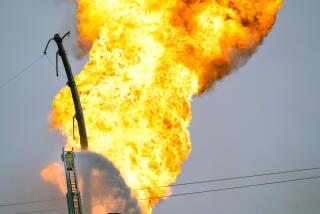Alaska Oil Pipeline Reopens Following Post-Quake Repairs
ANCHORAGE, Alaska — Oil began flowing through the trans-Alaska pipeline again Wednesday morning, after crews made repairs following a magnitude 7.9 earthquake Sunday that moved the line up to 7 feet in places.
“They’re slowly, slowly, slowly ramping up,” said Mike Heatwole of Alyeska Pipeline Service Co. “They’re going to watch that section closely.”
The line, which carries about one-sixth of the nation’s oil production, was shut down after Sunday’s earthquake. There were no leaks or spills, but the pipeline moved horizontally during the temblor, and some supports were damaged.
Aftershocks were continuing in the region around the damaged pipeline supports, and Marnie Isaacs of Alyeska said officials want to make sure temporary supports placed under the line in several places are adequate to absorb new quakes.
Tanker loading at Valdez could resume as early as this morning, Heatwole said.
Aside from halting the oil flow, Sunday’s quake caused major damage to roads and some other facilities.
State officials said temporary repairs were in place allowing traffic to move on most major roadways.
The cost of repairing quake-damaged roads will be about $20 million, said Joseph Perkins, commissioner of the Department of Transportation and Public Facilities.
The Alaska Earthquake Information Center reported two minor quakes Wednesday morning, one magnitude 3.9 and the other 4.0. Dozens have been logged since the major quake Sunday.
The affected area of the pipeline is about 150 miles south of Fairbanks in a region that was known to be earthquake-prone when the line was built. Special precautions were taken along that section of the line, which is above ground.
The Sunday earthquake was reportedly so strong that it churned up waves on a Louisiana lake and rippled swimming pools on the East Coast. It also temporarily muddied well water in homes more than 3,000 miles away, geologists said.
Well-drilling companies got scores of calls this week from Pennsylvania customers complaining about water turning cloudy or muddy.
“It was really brown, like diluted iced tea,” said Joanne Volm of Harleysville, Pa. “The kids didn’t want to bathe in it.”
Waverly Person, a U.S. Geological Survey geophysicist in Golden, Colo., said stirred-up wells were widespread.
“This type of phenomenon happens with big, shallow earthquakes,” Person said. “The surface waves from this earthquake were recorded for hours and they were just rolling around and around the Earth.”
Despite the strength of Sunday’s quake, no serious injuries were reported.
More to Read
Sign up for Essential California
The most important California stories and recommendations in your inbox every morning.
You may occasionally receive promotional content from the Los Angeles Times.










